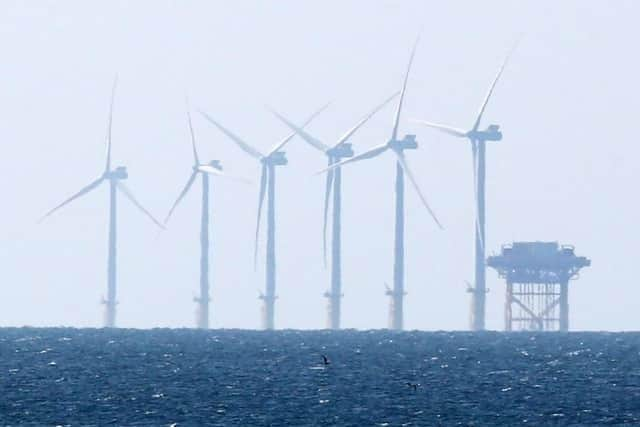Rampion 2: New Sussex wind farm would be 'silent ecosystem killer', claim campaigners who will 'reconsider living in the area'
and live on Freeview channel 276
Proposals to build Rampion 2 – an extension to the existing Rampion wind farm – were the subject of a successful Development Consent Order (DCO) application. The plans will now be examined by the UK Government’s planning inspectorate.
Campaign group Protect Coastal Sussex has expressed serious concerns over the controversial £3bn project.
Advertisement
Hide AdAdvertisement
Hide AdCampaigners fear the ‘adverse impacts’ of the wind farm would ‘demonstrably outweigh the benefits’ for both current and future generations of residents and visitors – as well as wider society. They also claimed that there ‘reasonable alternatives’ offer ‘better value for money’.


A spokesperson added: “A silent ecosystem killer, an attempt to save nature by trashing it.
“The sheer scale of the Rampion 2 scheme in environmentally sensitive inshore waters with a cleared transmission right-of-way through a National Park will disrupt and permanently degrade ecosystems in the sea, on the land and in the air, both during construction and operation.
"It will make them less resilient and even more vulnerable to long-term climate change. In human terms, it will substantially degrade intrinsic values of the natural seascape and landscape impacting on the wellbeing of many.”
Advertisement
Hide AdAdvertisement
Hide AdThe Rampion 2 plan was scaled back last year following public concern. The extent of the offshore wind turbine array proposals were reduced by nearly half and the maximum number of turbines were decreased from 116 to 90.
It was estimated that the offshore turbines – which would be around 13 kilometres from the coast between Brighton and Littlehampton – could power one million homes and ‘reduce carbon emissions by around 1.8 million tonnes per year’.
This means Rampion and Rampion 2 combined will be able to power the equivalent of all of the homes in Sussex twice over.
Rampion 1 is based in the English Channel between 13 and 20 kilometres (km) from the Sussex coast, and stretches from East Worthing in the west, to Brighton in the east. If given the go ahead, Rampion 2 would be situated to the west of the existing offshore wind farm and would include up to 90 turbines a minimum of eight miles offshore.
Advertisement
Hide AdAdvertisement
Hide AdSpeaking during the statutory public consultations, Nick Gibb, MP for Bognor Regis and Littlehampton, said: “I support the government’s aim for the UK to be a world leader in renewable energy and the ambitious programme to tackle climate change, but this stretch of the West Sussex coastline is an inappropriate location for such a large wind farm.
"The English Channel is too narrow to enable the turbines to be positioned far enough out to sea to be acceptable. This proposal does not, therefore, comply with the government’s recommendations for offshore wind farms of this size.”
Andrew Griffith, MP for Arundel and South Downs, described the new cable route as a ‘cable motorway’ – through communities within the Arun and Horsham districts, and across the South Downs National Park protected landscape.
He added: “Its construction phase alone is expected to disrupt households and businesses in West Sussex for many years.”
Advertisement
Hide AdAdvertisement
Hide AdRWE – one of the globally leading renewables companies – is leading the development of Rampion 2 on behalf of partners, including a Macquarie-led consortium and Enbridge Inc.
Consultation on the project started in January 2021, followed by a nine-week statutory project-wide consultation launched in July 2021, promoted by a publicity campaign which attracted 12,500 visits to the project website hosting the consultation proposals. The chosen site for an onshore substation, Oakendene, near Cowfold, was announced in July 2022.
However, Protect Coastal Sussex and other community organisations wrote to local councils last month, ‘documenting the consultation inadequacies they witnessed’.
The campaigners alleged that the company failed to ‘fully implement’ the Statement of Community Consultation – where the developer sets out how it would conduct consultations.
Advertisement
Hide AdAdvertisement
Hide AdA spokesperson for Rampion 2 said that, now that the DCO application is accepted for examination by the planning inspectorate – in accordance with Section 56 of the Planning Act 2008 – the project team will publicise notices of the accepted application in local and national newspapers, setting out how the community can register their opinions with the planning inspectorate.
The public will be able to view the final proposals and register as an ‘interested party’ at the project page of the planning inspectorate website.
The spokesperson for Protect Coastal Sussex (PCS) – which has members in Aldwick, Middleton-on-Sea, Littlehampton and Cowfold – added: “We fully appreciate that people – with good intentions at heart – in our communities would support a commercial application to install wind turbines anywhere, at any cost to the environment, without the facts and therefore the wellbeing of others.
"If it ticks the green box it cannot be refused. Other informed residents see the impacts of Rampion 2 will be so substantial and transformative, even to the point they will reconsider living in the area.
Advertisement
Hide AdAdvertisement
Hide Ad“PCS argues that we must sensibly prioritise and develop the most efficient wind projects, those which are truly offshore in the best wind regimes and preferably connected to an offshore ring grid. Wind power can then play its optimal role in our generation mix and climate strategy – not divide and disrupt communities.”
Rampion 2 said the examination process is expected to take six months, and a final decision on whether consent will be granted will be made by the Secretary of State for the Department of Energy Security and Net Zero by early 2025.